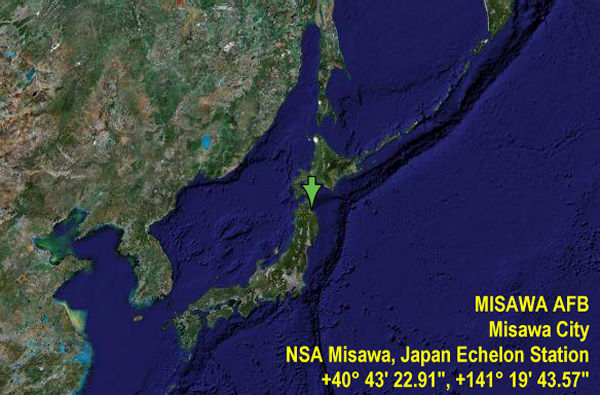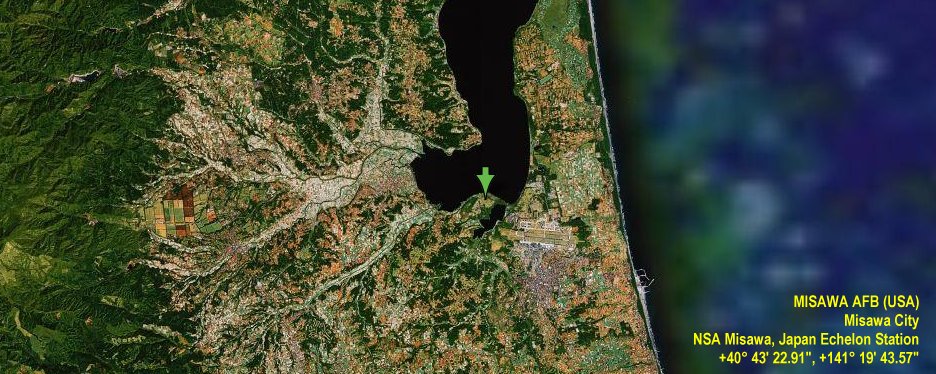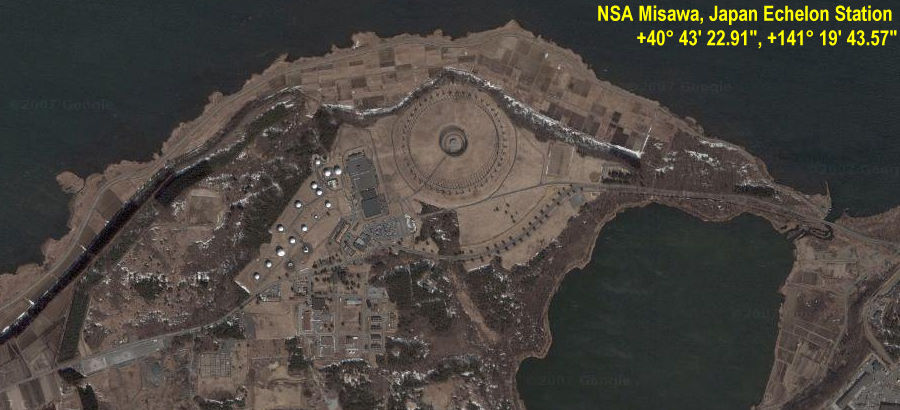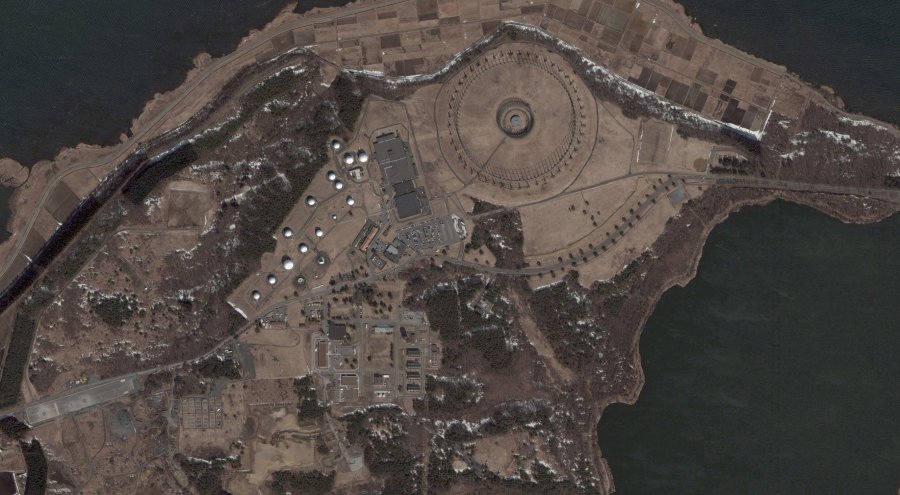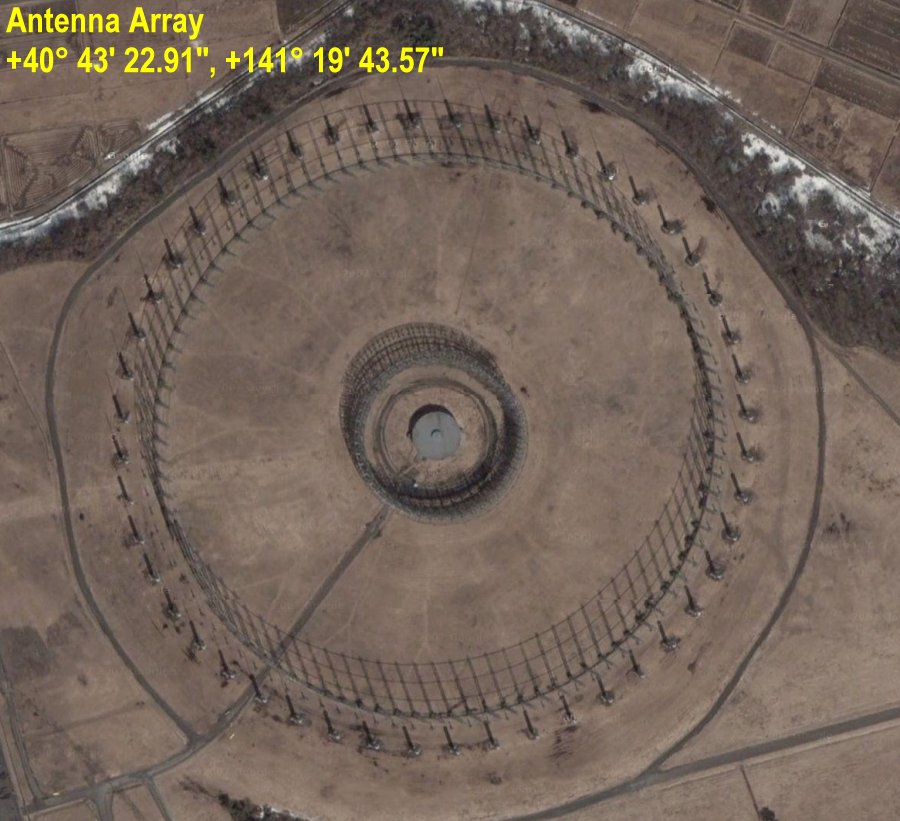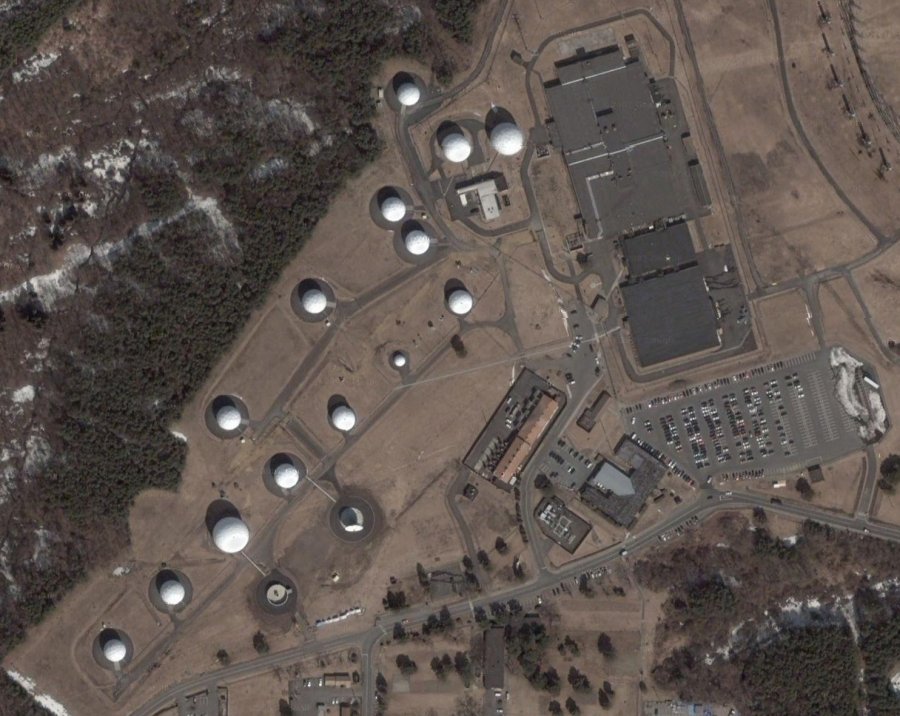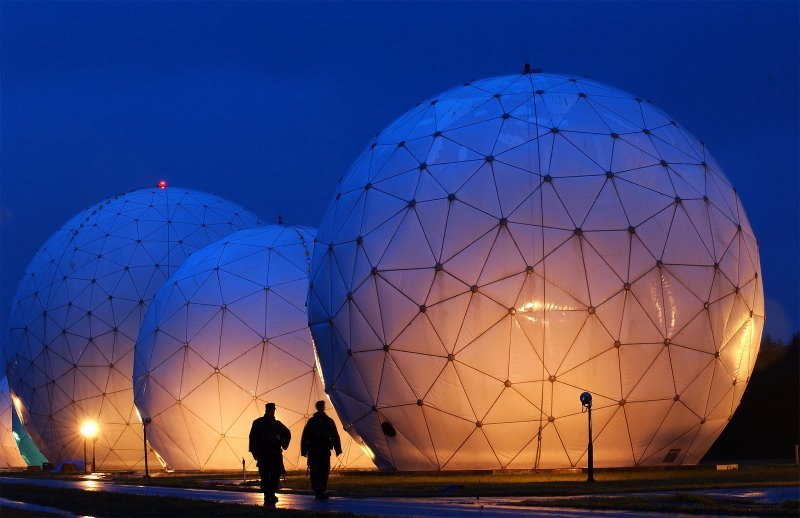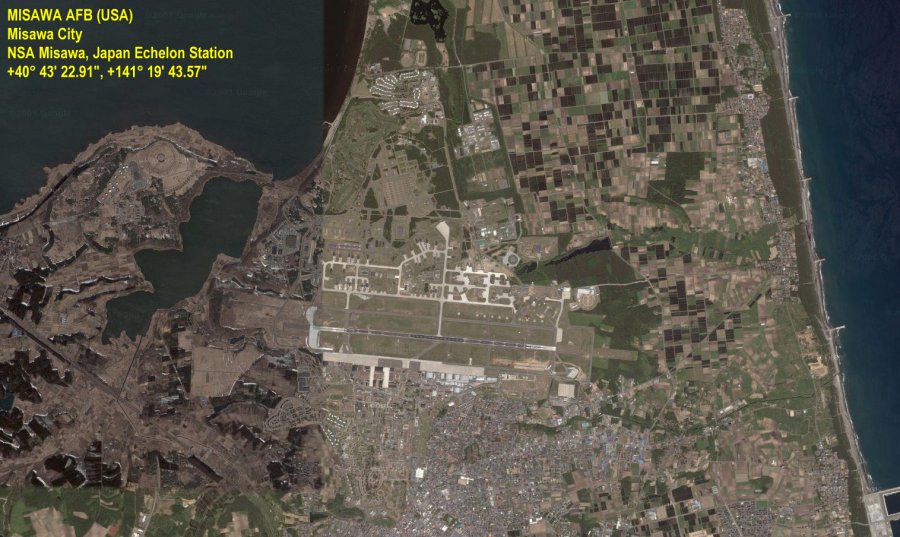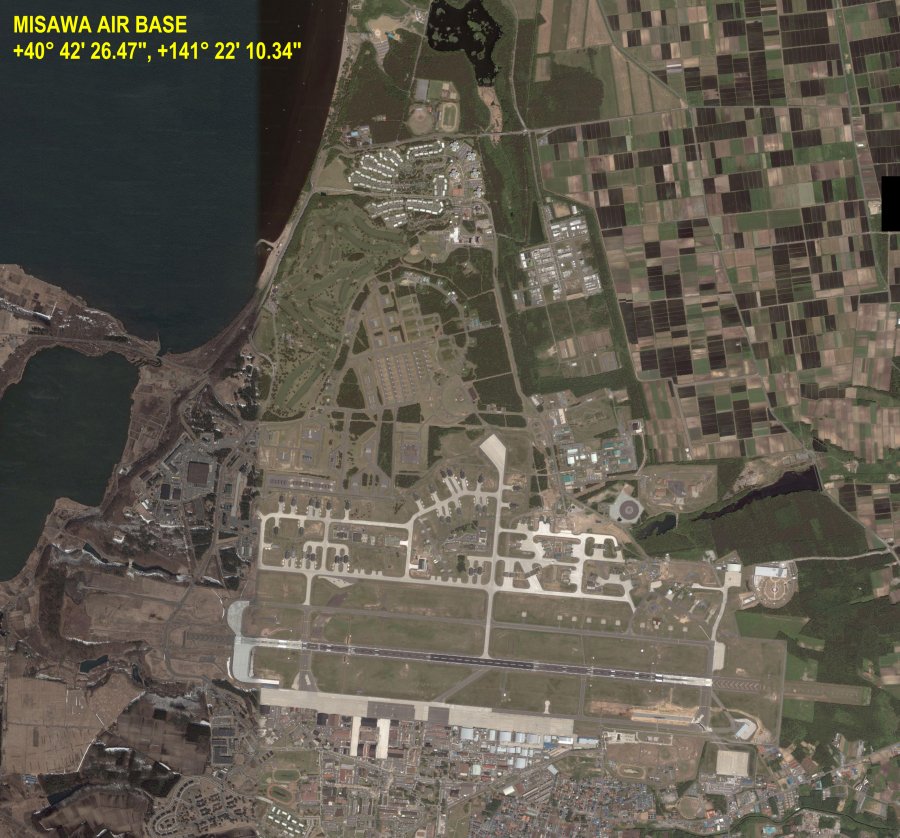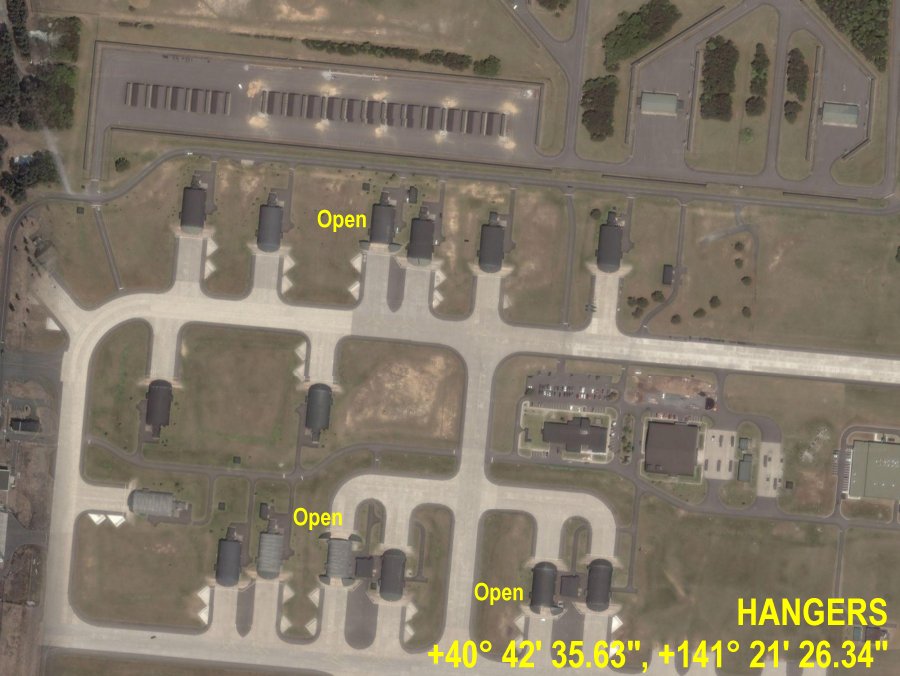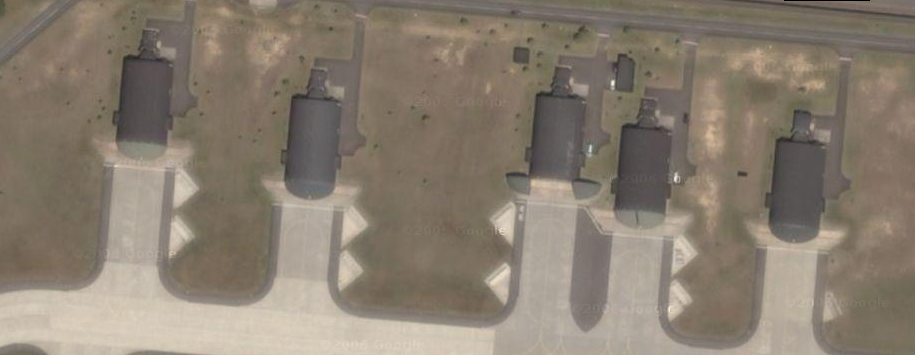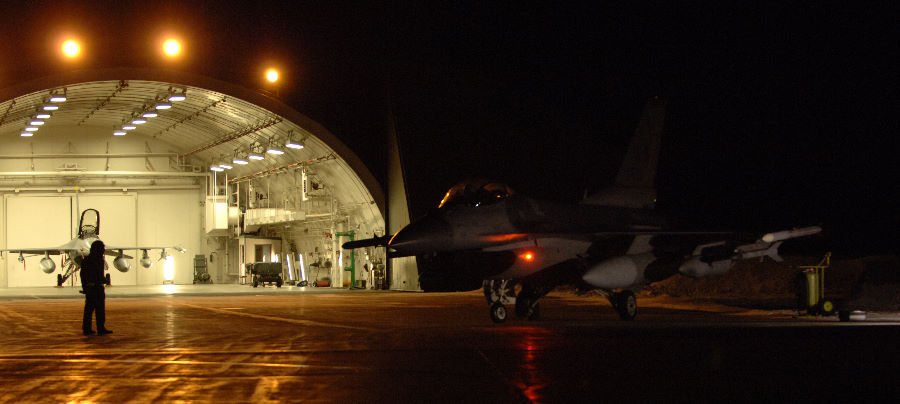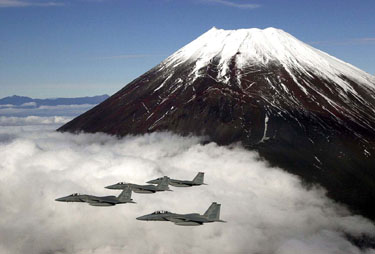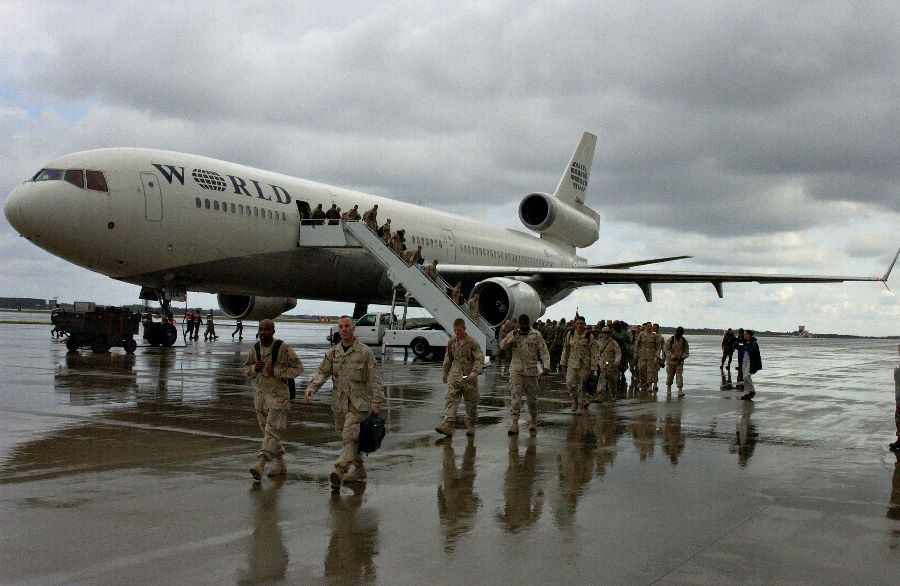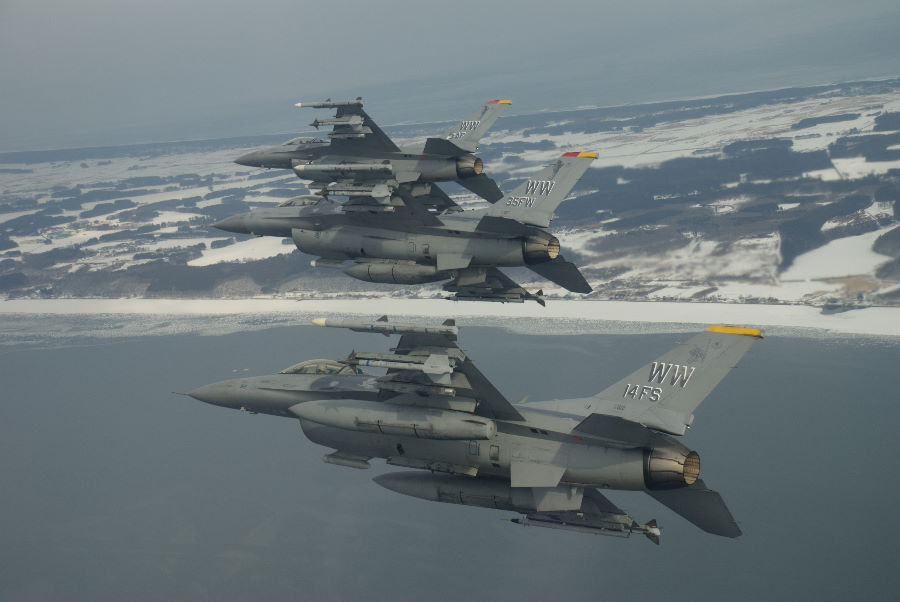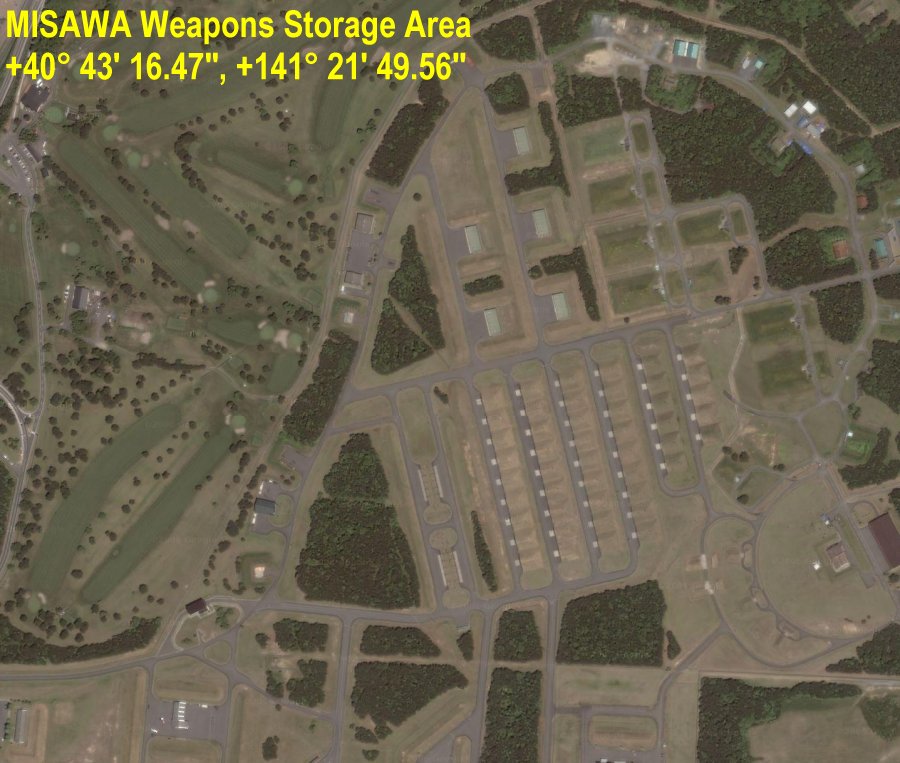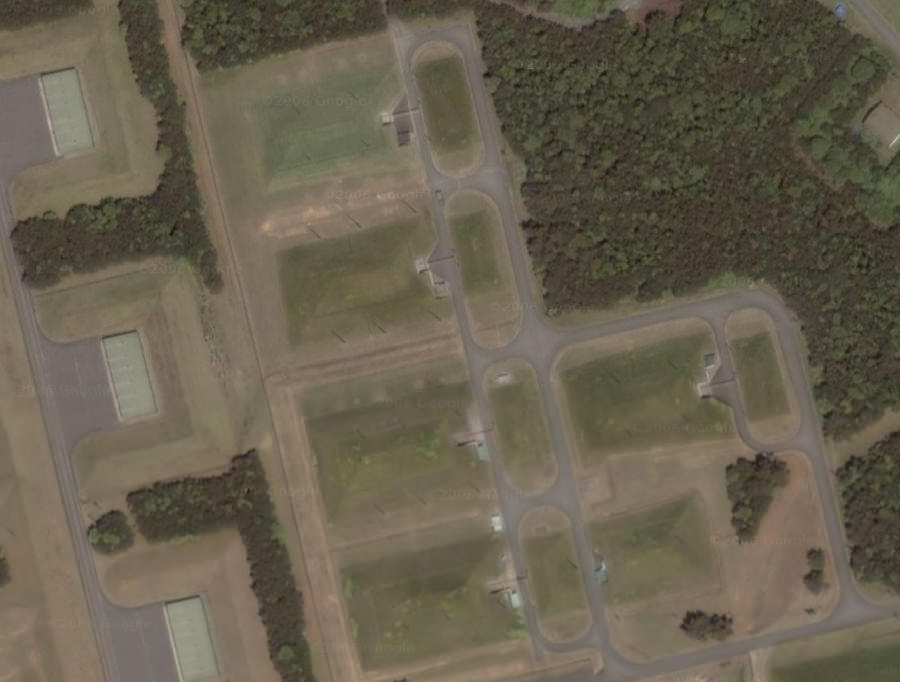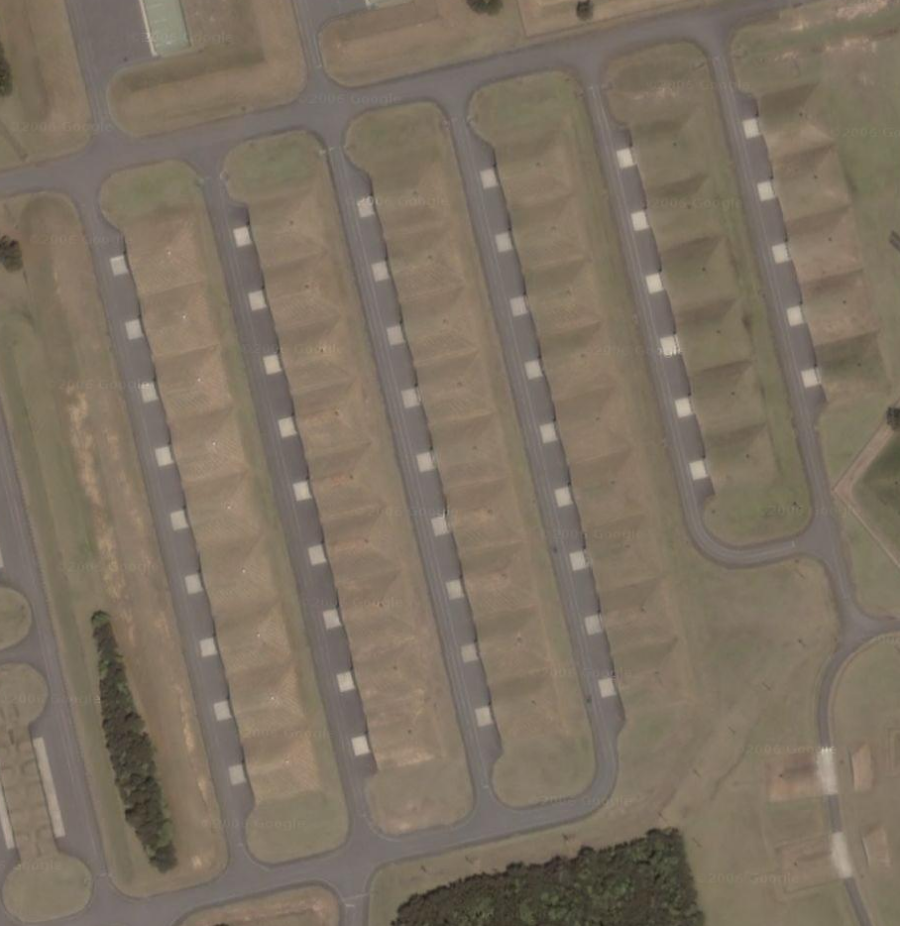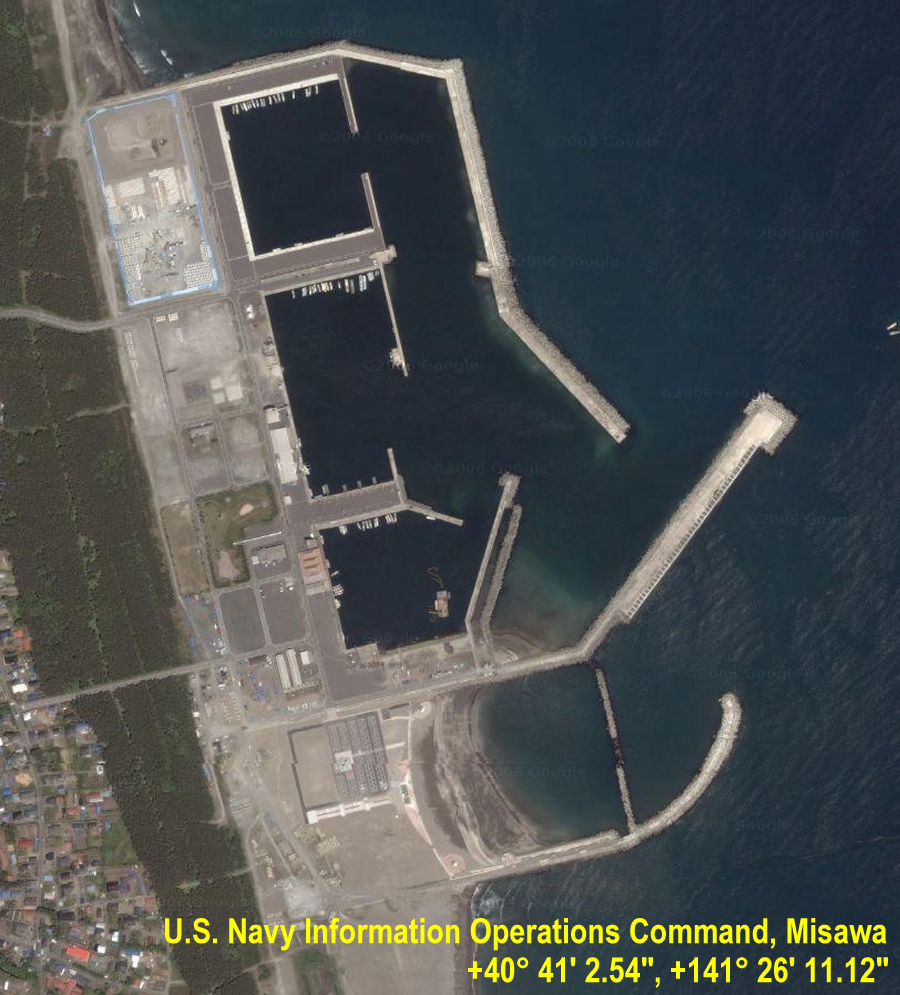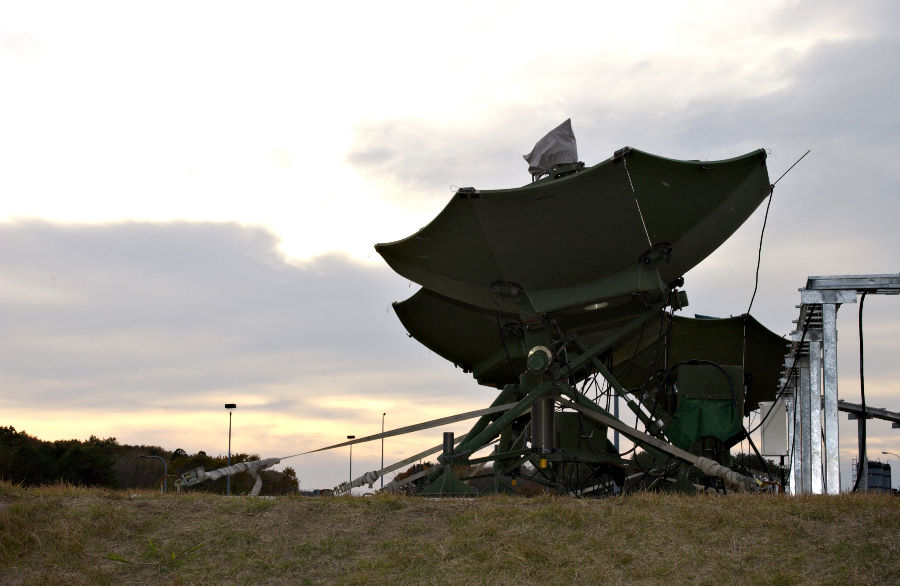|
|
|||||
|
Misawa NSA Echelon Station Code Name: Ladylove +40° 43' 22.91", +141° 19' 43.57" ..
Misawa hosts a United States Air
Force base, Misawa Air Base. The base is currently home to the 35th Fighter
Wing, The conjoined home of the American and Japanese militaries.
During the Cold War and after, it was the site of an important US base for signals intelligence and related activities. As of 2003, the Misawa Security Operations Center (MSOC), is comprised of components from the DOD, the 373rd Intelligence Group, the 403rd Military Intelligence Detachment and the US Navy Information Operations Command Misawa. MSOC was formerly known as the Misawa Cryptologic Operations Center. SOURCE: Wikipedia
Map showing the Misawa ECHELON Station (upper right green area) and the Misawa Air Base (arrow)
In addition to the Navy, Misawa Air Base also hosts US Army, Marine Corps and Air Force units in conjunction with Japanese Air Self Defense Forces. The camaraderie and interaction among all the services is unparalleled. Opportunities abound for Sailors to join a team of 1,200 plus personnel, whose mission is support. In addition to the Naval Air Facility and Naval Security Group Activity, Misawa also is home to Naval Pacific Meteorology and Oceanography Det., Personnel Support Det., Patrol Wing 1 Det, and Mobile Mine Assembly Unit 12 — to name only a few. Nearly every rate is represented somewhere at NAF Misawa. U.S. Naval Communications Detachment (NAVCOMM Det) Misawa was officially established in February 1991. NAVCOMM Det Misawa is a tenant command of U.S. Naval Air Facility Misawa, Japan, which is located on 35TH Fighter Wing Air Base Misawa, Japan. NAVCOMM Det Misawa's primary mission is to provide reliable communications support for Commander, SEVENTH Fleet and supporting units, U.S. Naval Forces Japan, Defense Information Systems Agency and the Japanese Maritime Self Defense Force. The detachment operates and maintains the Tactical Support Communications Center in support of Patrol and Reconnaissance Wing One Detachment Misawa, and operational deployed commander, Commander Task Group 72.4. Additionally, the detachment provides CMS, STU-III, GATEGUARD, and DMS equipment along with training and technical assistance to Naval Air Facility, Commander Task Group 72.5 and 12 tenant commands. SOURCE: http://www.globalsecurity.org/military/facility/misawa.htm
|
|||||
..
|
|||||
Radome Three radomes at the Cryptologic Operations Center, Misawa Air Base, Japan. Short for "radar dome", a radome is a weatherproof enclosure used to protect an antenna. It is used mainly to prevent ice (especially freezing rain) from accumulating directly onto the metal surface of the antenna. |
|||||
|
Misawa Air Base ..
Misawa Air Base The 35th Fighter Wing is the host unit at Misawa Air Base, Japan -- the northernmost U.S. air base in Japan. The only combined, joint service installation in the Western Pacific, Misawa Air Base is located on the shores of Lake Ogawara in Misawa City in the Aomori Prefecture. The wing's mission is to "help defend Japan and promote regional security in the Pacific by providing forward presence, deployable forces, and quality mission support." 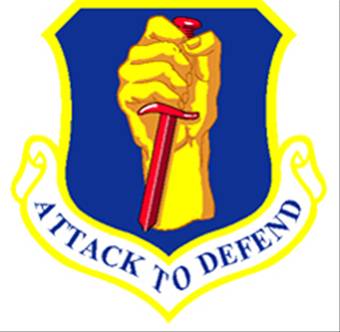 The wing flies two squadrons of
the Block 50 model F-16CJ and F-16DJ Fighting Falcon. The wing conducts
daily F-16 flight training to maintain its combat readiness edge. Its pilots
fly air-to-air weapons delivery exercises over water and sharpen their
air-to-ground skills using the ripsaw gunnery range located 12 miles north
of Misawa.
In addition to its flight training schedule, the wing holds quarterly local operational readiness exercises, which allow its people to concentrate training on war fighting skills essential for readiness. The 35th Fighter Wing also maintains its readiness by participating in Pacific Air Forces-sponsored exercises, including Cope Thunder in Alaska, and joint U.S. forces exercises, such as Cobra Gold in Thailand. Three times a year, the wing participates in 5th Air Force-sponsored Cope North bilateral exercises involving the United States and Japan. Four groups are assigned to the 35th Fighter Wing: the 35th Logistics Group, 35th Medical Group, 35th Operations Group and 35th Support Group. The 35th Fighter Wing also serves as the host unit to a variety of associate units representing all four U.S. military services. These units include Naval Air Facility Misawa, Naval Security Group Activity Misawa, Company E Marine Support Battalion, 301st Intelligence Squadron, 3rd Space Surveillance Squadron and the Army's 750th Military Intelligence Company. HISTORY: Although originally activated at Johnson Air Base, Japan, on Aug. 18, 1948, the wing carries bestowed honors of the 35th Fighter Group, which traces its origin back to Dec. 22, 1939. Through various reorganizations, redesignations, inactivations and reactivations, many installations at various points around the globe have been home to the 35th Fighter Wing and its changing mission. Its original mission was to fly air defense over Japan, but in 1950, the wing deployed a tactical group and two squadrons to support ground forces during the Korean War. From 1971 to 1992, the 35th was assigned to George Air Force Base, Calif. During Operation Desert Storm, the 35th operated out of Saudia Arabia and played a key role in the war's successful air campaign by flying 3,072 combat missions totaling more than 10,000 hours. From May 1993 to September 1995, the 35th was based at Naval Air Station Keflavik, Iceland. After a 37-year absence, the 35th Fighter Wing returned to its roots Oct. 1, 1994, when it replaced and assumed the mission of the 432nd Fighter Wing at Misawa Air Base. Throughout the 35th Fighter Group's and 35th Fighter Wing's five-decade history, it has flown 24 different aircraft. Its major unit awards and citations include one Distinguished Unit Citation, three Presidential Unit Citations, six Air Force Outstanding Unit Awards with Combat "V" device, five Air Force Outstanding Unit Awards, and three Republic of Vietnam Gallantry Crosses with Palm. 35TH FIGHTER WING GOALS -- Maintain a High State of Readiness -- Enhance our Community's Quality of Life -- Forge a Responsive Support Structure -- Strengthen U.S. - Japanese Relationships SOURCE: Fact Sheet: 35TH FIGHTER WING MISSION OFFICIAL AIR FORCE SITE: http://www.misawa.af.mil/
..
..
Flightline Night Ops MISAWA AIR BASE, Japan -- A 13th Aircraft Maintenance Unit crew chief helps prepare an F-16 Fighting Falcon for takeoff during the early morning hours Jan. 18, 2008. Members of the 13th Fighter Squadron were headed to Eglin Air Force Base, Fla., to participate in the Combat Hammer weapons system evaluation program. (U.S. Air Force photo by Chief Master Sgt. Michael Atkinson) (RELEASED) (Click on image for full size) |
|||||
PACAF’s 5th Air Force in Japan comprises fighters, mobility aircraft, and intelligence-surveillance-reconnaissance airplanes at Kadena, Misawa, and Yokota air bases. Pictured are F-15s flying past Mt. Fuji, near Tokyo.(USAF photo by MSgt. Marvin Krause) ..
MISAWA AIR BASE, Japan -- Members of Misawa Air Base
disembark to go meet family and friends after returning from Iraq Oct.
5, 2007. The Airmen are returning after several months of support for the
Global War on Terrorism. (US
Air Force photo by Airman 1st Class Eric Harris) (RELEASED) (Click
on image for full size)
MISAWA AIR BASE, Japan -- F-16 fighter jets perform an echelon turn over Misawa Air Base, piloted by (farthest to closest) Lt. Gen. Bruce Wright, 5th Air Force commander; Col. T.J. O'Shaughnessy, 35th Fighter Wing commander; and Lt. Col. Charles Toplikar, 14th Fighter Squadron commander, Feb. 6, 2008. This was General Wright's final flight in the 5th AF flagship fighter jet. (U.S. Air Force photo by Lt. Col. Judd Fancher) (RELEASED) (Click on image for full size) |
|||||
|
Misawa Weapons Storage Area (WSA) ..
..
..
.. Japan Policy & Politics, Dec 20, 1999 Excerpt: In addition, U.S. State Department records show Japan agreed with the U.S. to allow the storage of nuclear weapons on the islands in the event of an emergency. The agreement, the exact wording of which remains classified, was reached April 10, 1968, shortly before the islands were returned to Japan in June that year, according to the report. The confidential pact was arranged between Japanese Prime Minister Eisaku Sato and U.S. President Lyndon Johnson under strong pressure from the U.S. military, the researchers said, citing State Department documents obtained at the National Archives. The agreement became an "important precedent for a similar nuclear storage arrangement reached in 1972 when the U.S. returned control of Okinawa to Japan," Burr said. The report also said the State Department feared the possibility that the "U.S.-oriented" ruling Liberal Democratic Party would collapse if the secret arrangements on nuclear deployment were leaked. The council also quoted the declassified 1956-1957 Far East Command's "Standing Operating Procedures for Atomic Operations" as saying that "13 separate locations in Japan had nuclear weapons or components, or were earmarked to receive nuclear weapons in times of crisis of war." The researchers said it was possible that bombs without their fissile cores were stored at U.S. bases on the main islands of Japan, including bases in Misawa, Atsugi, Iwakuni, Komaki, and Iruma. It also pointed out that nuclear-armed ships were stationed in Sasebo and Yokosuka in Japan during the Cold War. Norris said that the U.S. military never had nuclear deployment rights for mainland Japan, however. SOURCE: http://findarticles.com/p/articles/mi_m0XPQ/is_1999_Dec_20/ai_58533992
|
|||||
|
U.S. Navy Information Operations Command ..
U.S. Navy Information Operations Command U.S. Navy Information Operations Command Misawa is a command of 300 sailors which continues a long-standing reputation for excellence handed down by our predecessors since 1971. We are a tenant command on Misawa Air Base, located approximately 400 miles north of Tokyo, adjacent to Misawa City in the Aomori Prefecture. Command History The origin of U.S. Navy Information Operations Command, Misawa dates back to December 1945 when RM1 Brillhart was Petty Officer in Charge of COMMSUPACT in Ohminato, Japan. In April 1946, COMMSUPACT operations moved to Yokosuka, Japan. Twelve years later operations were relocated to Kamiseya, Japan with CDR C. M. Smith as head of NAVSECGRU Department NAVCOMMSTA Kamiseya. U. S. Naval Security Group Activity, Kamiseya was established on 15 January 1960, under the command of CAPT E. W. Knepper. The activity remained on the Kanto Plain until March 1971 when most functions of NIOC Kamiseya were moved to Misawa. On 1 July 1971, U.S. Navy Information Operations Command, Misawa was commissioned under the command of CAPT G. P. March. Today's NIOC Misawa has continued its reputation for excellence begun by its predecessor organizations by capturing numerous awards. The command won the coveted Director, National Security
Agency Travis Trophy for cryptologic excellence in 1975, 1980 and 1989,
the Joint Meritorious Unit Award in 1997, and has been awarded four Meritorious
Unit Commendations. The command received the Air Force Outstanding Unit
Award in 1995 and 1999. NIOC Misawa won the COMNAVSECGRU Gold Anchor personnel
retention award for 1979, 1980, 1985, 1992, 1994 and 1999, as well as the
Silver Anchor in 1987, 1989 and 2000. The command received the Navy Bronze
Hammer Award for self-help projects during 1978 and 1979, and was awarded
the 1995 COMNAVSECGRU Maintenance Award. NIOC Misawa was the COMNAVSECGRU
Maintenance Best Bachelor Enlisted Quarters (BEQ) for 1991-1995, and won
the Zumwalt Award for best medium-sized BEQ in the Navy for 1991, 1993,
1994, 1995, 1997 and runner-up in 1992. Other recent awards include the
COMNAVSECGRU Tenant Command Safety Award for 1992 and runner-up in 1994,
the Best News or News Feature Magazine in the Chief of Information Merit
Award 1992 and runner-up in 1994. Finally, it was recognized in 1995 and
2000 by COMNAVSECGRU as the Command Language Program of the Year (RADM
G. P. MARCH AWARD).
..
OFFICIAL NAVY SITE: http://www.niocmisawa.navy.mil/ |
|||||
|
..
MISAWA AIR BASE, Japan -- Satellites for the Joint Tactical Ground Station sit on the JTAGS compound here Nov. 6, 2007. The Army's newest JTAGS facility officially opened here Jan. 22, 2008. (U.S. Air Force photo by Airman 1st Class Eric Harris) (RELEASED) (Click on image for full size) U.S. Army Activates X-Band Radar in Northern Japan September 28, 2006 :: AP :: News The U.S. Army has now activated an X-band radar in northern Japan to track regional ballistic missiles. On Tuesday, September 26, Brigadier General John E. Seward hosted a ceremony at Camp Shariki in the northern Aomori state to activate the X-Band radar. The system was moved earlier this summer from the U.S. military’s Misawa Air Base in Misawa, also in northern Japan. The two nations began working on the radar in 1998 after North Korea fired a Taep’o-dong 1 ballistic missile over northern Japan. The powerful X-band radar can identify objects from thousands of miles away and is designed to differentiate between decoys and real missile warheads. It is part of an ongoing U.S. and Japanese collaboration on missile defense that includes the joint production of sea-based Standard Missile-3 interceptors capable of destroying incoming missiles and the deployment of land-based Patriot Advanced Capability-3 interceptors around Japan. SOURCE: http://www.missilethreat.com/archives/id.276/detail.asp |
|||||
| FAIR USE NOTICE: This page contains copyrighted material the use of which has not been specifically authorized by the copyright owner. Pegasus Research Consortium distributes this material without profit to those who have expressed a prior interest in receiving the included information for research and educational purposes. We believe this constitutes a fair use of any such copyrighted material as provided for in 17 U.S.C § 107. If you wish to use copyrighted material from this site for purposes of your own that go beyond fair use, you must obtain permission from the copyright owner. | |||||
|
|
